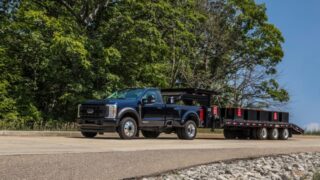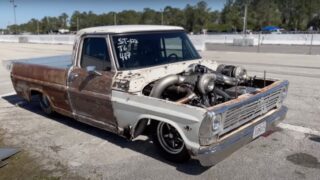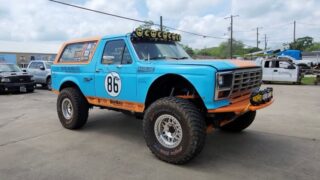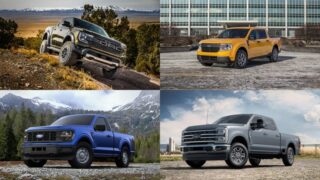Ford FE V8 Engine Build, Part One
Barry’s Engine Room
This is going to be the first in a series of articles dedicated to engine building. I am going to start off from "ground zero" and work my way up to a finished piece on paper – – or in this case – – on monitor. First item is a very brief background on me. I am a drag racer, an ASE certified Master Automotive Technician, and a competitor in the Popular Hot Rodding Engine Master’s Challenge. I spent the past twelve years managing Speed-Pro, prior to that I worked at Holley for eight years. In those twenty years I have seen more examples of parts and practices that worked – – or didn’t – – than the average guy can ever hope to see. It is my intent that this series helps you in making good choices and getting good results as you take on your next engine building project. Some of my comments are personal opinions formed from those years of experience – – and they may not agree with your own ideas, or with popular marketing messages. Learn what you can, disregard what you feel you should, and hopefully we can all come away with a clearer view of engine building and design.
The Plan
The seemingly obvious first questions in any engine project are "What engine am I going to build?", "How much do I intend to spend?", and "What am I planning to do with it?". These seem pretty straightforward, and sometimes are predetermined by circumstances – – but are still worthy of consideration. There are innumerable ways to build any given engine. With so many component and service options available it becomes very important to develop a plan for the engine and a realistic set of goals. Throughout this series you will read two common lines – – "managing expectations", and the concept of "good enough".
The majority of engines are selected because they’re what we already have in the truck, or have quick access to. Although never mentioned in the average magazine, the cheapest and fastest way to simply get your truck running is snagging a running engine from a yard or donor vehicle. While this series will concentrate on building an engine it’s always good to keep the budget in that context – – a mildly rebuilt 352 will probably still not outperform a good running used 390. You can’t often get big high RPM power, strong low end pulling torque, good gas mileage, and low cost to all fit into a single combination. Component selection becomes a game of compromises, weighing the advantages of cost, power, durability, and availability for each product and service chosen as the engine comes together. This is what I mean by "managing expectations".
For this engine series I am going to build a fictional 390 Ford engine. A couple reasons – – they are readily available as cores, they represent an intuitive upgrade for trucks equipped with 352s or 360s, and they can deliver a good combination of power and durability on a "beer budget". That and the fact that I really like FE’s a lot. My target application is a lightly modified early 70’s F150 that is used for normal transportation, as well as to occasionally pull a trailer with a small boat, cycles, or snowmobiles. We’re going to assume 2WD, automatic, a 3.73 rear, a need to run on pump premium at the most. This package will drive well, rarely see beyond 5000 RPM, and will be able to cruise all day at 1500-2000 RPM without sputtering or fouling plugs. Since I want to discuss repair and inspection procedures we will not opt for a new stroker kit – – although more cubic inches are an ideal choice for our target vehicle. If I were building this for real I would recommend a Scat 3.98 stroke crank and a set of Probe forged pistons for a stronger 416 inch package.
The Donor
Lets pick out our donor engine – – the one we’ll use for the build. There are no guarantees on getting a rebuildable used engine – – but there are a few things you can do to help the odds. My favorite cores will be unmolested originals with little regard for mileage or original application. You may not find such an animal anymore, but they are worth looking for. Look for signs of previous major repairs – the telltale pieces of blue Fel-Pro gasket sticking out tells you that the heads have been off. Redone engines will often be painted in a non-Ford spray can blue that is too neon bright or too dark. Original pan gaskets are cork while replacements are paper and usually have plenty of silicone oozing out from the seams. Original FE engines had no gaskets between the exhaust manifold and the heads. The oil should still be visible on the stick and should not have a gritty feel or a burnt odor. A nice layer of goo from dried oil, weeping freeze plugs, and road dirt is actually a good thing in this context. Identifying a 390 from a 360 can be tough – – but if we goof it’s not too hard to make the upgrade by picking up a crank and a set of rods. If you find an FE in a mid to late 60’s passenger car such as a T-Bird or LTD you are almost certain to be looking at a 390. The "gold" we are panning for is an engine that has not already been bored out to its limits or machined improperly. An added bonus is getting the required ancillary pieces – – brackets, clips, mounts, and such can be very hard to chase down later.
Tearing it down
We bring our grand find home and begin the disassembly process. First we’ll get the oil drained out and maybe take a quick pass with a pressure washer to get it ready to work on. Grab your digital camera and take occasional photos as you remove components – – it is near impossible to remember where everything was a few weeks later. A bunch of zip bags and a permanent market can be invaluable in keeping parts organized. Go slow, pay attention, and take notes on odd stuff that looks worn or wrong as you take it apart. We’ll cover each item in detail later – – but you want to identify potential trouble spots as soon as you find them. Most small parts are going to get replaced or refurbished and are therefore not location critical – – but main caps and rod caps MUST be marked and returned to their original location in the block or on the rod. I prefer to use an inexpensive etch marker over a stamp for this – – but both will work. I also prefer to use hand tools for everything – but an impact is nearly mandatory to remove balancer, head, main cap, and flywheel fasteners on an old engine. Just be sure to use a six point socket and not to damage the fasteners. Everything needs to be removed from the engine – – every bracket, bolt, plug, and bearing. I will lightly reinstall the main caps once the block is apart to keep them in order. If you find something badly hurt – – like a spun main or cam bearing or a broken casting – – this is the time to find another candidate, rather than throw money at a wounded piece. You may need to use a can of carb cleaner to free up gummy lifters, and a rentable "ridge reamer" if there is a significant wear ridge in the cylinders – – which would make piston removal pretty tough.
Cleaning the house
The block will need to be thoroughly cleaned before any detailed inspection or machining can take place. A motivated guy with a bunch of scrub brushes, detergent, swear words and muscle can go a long ways, but I much prefer using a commercial cleaning service. Most machine shops will use one of, or a combination of hot solvent tanks, high temperature pressure washers, baking, or a media blast process to clean castings. My favorite is a process involving a flame degrease followed by an acid chemical bath and a neutralizer bath. This delivers a casting that is completely clean, new in appearance, and does not degrade any machined surfaces. This process is readily available in the Detroit area where I live – – but you may not have such options where you reside. Some folks contend that the temperatures used in such cleaning are detrimental to the castings – – but I have yet to experience any such issues after numerous builds. I have confirmation from a large block manufacturer that the temperatures used are many hundreds of degrees too low to have any metallurgical impact. The key here is simply to start out as clean as you can get it.
Inspection time
The cleaned up block is now ready for a critical inspection. Finding any flaws now will save you from wasted machining expenses, and wasted time. Look – – REALLY look – – for anything that is not right. You are going to see casting flaws and irregularities that won’t mean much. You are hoping not to find cracks that run from water jackets to head bolt holes, stripped or badly eroded main or head bolt threads, or cracks in the main cap area. Some wear in the cylinder is expected, and we will be overboring it anyways – – but major gouges, splits, and scrapes are cause for starting over. A rule of thumb is that you can just feel the OK stuff running your fingernail across it. Once you think you have a winner it’s time to bring it to your machinist and pay for a professional opinion. Depending on his equipment, opinions, and your power targets he may want to use a sonic tester to verify that the cylinder walls are thick enough for the boring and honing ahead, and he may take a magnetic particle inspection or use a dye penetrant to check for cracks not visible to the eye. Again the idea is to spend a little time and money eliminating any bad blocks now, rather than sinking hundreds into machining a piece that ends up not being suitable.
The same cleaning and inspection process applies to the cylinder heads and intake manifold – – if you are planning to reuse the originals. There is a good case to be made for repairing and reusing a good set of O.E. heads in a mild engine. It’s a lot tougher to defend that original 80 pound intake!
All the smaller parts are also going to need to be scrubbed ’til they sparkle, and all the fasteners should at the least be washed and wire brushed. One rule for me is no glass beads or sandblasting – – you never seen to really get rid of the media no matter how hard you try. If you must blast use plastic media or walnut shells. The debris they leave behind is far less destructive.
Stay tuned for more….
Barry, www.survivalmotorsports.com




